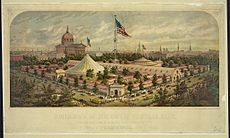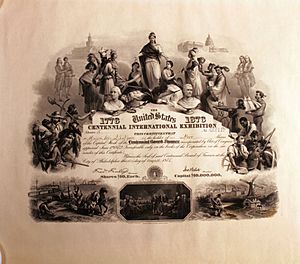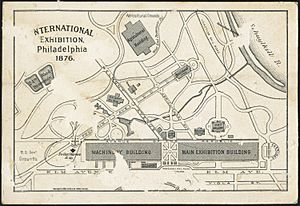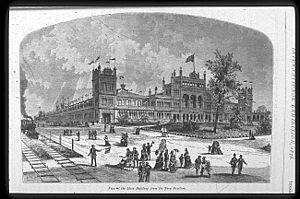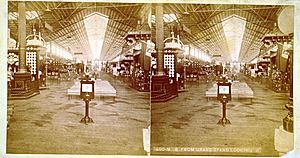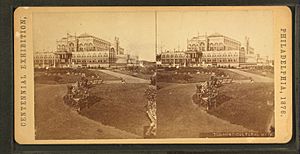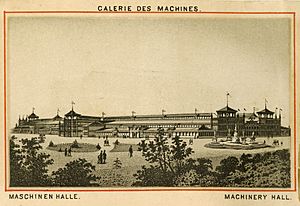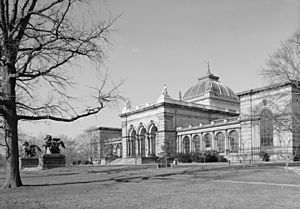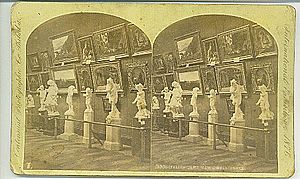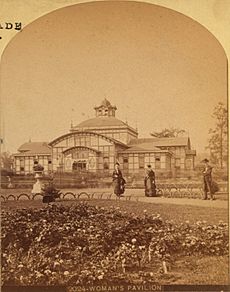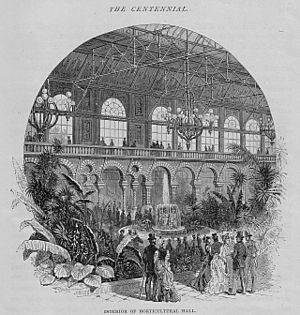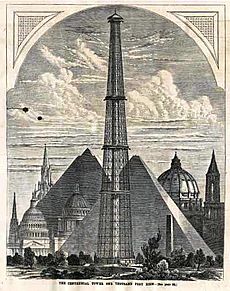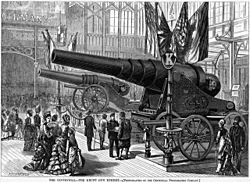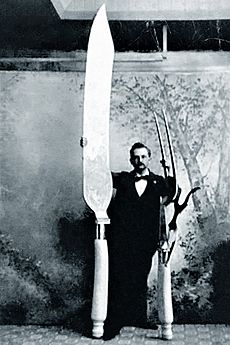Centennial Exposition facts for kids
Quick facts for kids Centennial International Exhibition of 1876 |
|
|---|---|
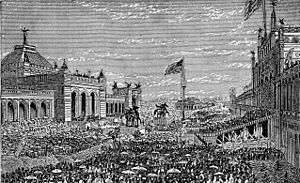
Opening day ceremonies at the Centennial Exposition
|
|
| Overview | |
| BIE-class | Universal exposition |
| Category | Historical Expo |
| Name | Centennial International Exhibition of 1876 |
| Building | Memorial Hall |
| Area | 115 ha |
| Invention(s) | Typewriter, Sewing machine, Telephone |
| Visitors | 10,000,000 |
| Participant(s) | |
| Countries | 35 |
| Business | 14,420 |
| Location | |
| Country | United States |
| City | Philadelphia, Pennsylvania, U.S. |
| Venue | Fairmount Park |
| Coordinates | 39°58′51.6″N 75°12′54″W / 39.981000°N 75.21500°W |
| Timeline | |
| Bidding | December 1866 |
| Awarded | January 1870 |
| Opening | May 10 – November 10, 1876 (6 months) |
| Closure | November 10, 1876 |
| Universal expositions | |
| Previous | Weltausstellung 1873 Wien in Vienna |
| Next | Exposition Universelle (1878) in Paris |
| Specialized expositions | |
| Next | Sesquicentennial (1926) |
The Centennial International Exhibition of 1876 was the very first official World's Fair held in the United States. It took place in Philadelphia, Pennsylvania, from May 10 to November 10, 1876. The fair celebrated the 100th anniversary of the Declaration of Independence, which was signed in Philadelphia.
Officially called the International Exhibition of Arts, Manufactures, and Products of the Soil and Mine, it was held in Fairmount Park. The fairgrounds were designed by Herman J. Schwarzmann along the Schuylkill River. Almost 10 million people visited the exhibition, and 37 countries participated.
Contents
How the Idea Started
The idea for the Centennial Exposition came from John L. Campbell. He was a professor at Wabash College in Indiana. In December 1866, Campbell suggested to Philadelphia's mayor that the 100th anniversary of the U.S. should be celebrated with a big exhibition.
Some people worried that there wouldn't be enough money. They also thought other countries might not come, or that American exhibits wouldn't look as good.
Early Support and Funding
The Franklin Institute quickly supported the idea. They asked the Philadelphia City Council to use Fairmount Park for the event. In January 1870, the City Council decided to host the Centennial Exposition in 1876.
A committee was formed to get support from the U.S. Congress. A bill was passed on March 3, 1871, to create a United States Centennial Commission. This bill stated that the U.S. government would not pay for any expenses.
The Centennial Commission was set up on March 3, 1872. Joseph Roswell Hawley was its president. Congress also created a Centennial Board of Finance to help raise money. This board could sell up to $10 million in shares, each costing $10.
Philadelphia gave $1.5 million, and Pennsylvania gave $1 million. Later, Congress loaned $1.5 million. The Women's Centennial Executive Committee, led by Elizabeth Duane Gillespie, also raised a lot of money. They even raised extra funds for a special building to show women's work.
In 1873, Alfred T. Goshorn was named the director general of the Exposition. The Fairmount Park Commission set aside about 450 acres (1.8 km²) for the event. The exhibits were divided into seven main areas: agriculture, art, education and science, horticulture, machinery, manufacturing, and mining.
Getting Ready for Visitors
To handle all the visitors, temporary hotels were built near the fairgrounds. A special agency helped people find rooms in hotels, boarding houses, and private homes. Philadelphia streetcars increased their service.
The Pennsylvania Railroad and the Philadelphia and Reading Railroad ran special trains. A small hospital was built on the grounds, and despite a summer heat wave, there were no major health problems.
Philadelphia also created 500 Centennial Guards. These guards helped keep order, found lost children, and returned lost items. They lived on-site in police stations built around the Exposition.
Designing the Fairgrounds
Herman J. Schwarzmann, an engineer for the Fairmount Park Commission, was the main designer. He had studied the Vienna International Exposition in 1873 to learn what worked and what didn't.
Schwarzmann designed important buildings like Memorial Hall and Horticultural Hall. He also planned the landscaping. He made sure the Philadelphia fair had good transportation, with direct train lines, trolley lines, and streetcar routes.
Main Buildings of the Exposition
More than 200 buildings were built for the Exposition. There were five main buildings: the Main Exhibition Building, Memorial Hall, Machinery Hall, Agricultural Hall, and Horticultural Hall. There were also separate buildings for different states, countries, and companies. This was different from earlier fairs that had only a few large buildings.
The buildings were made in two main styles: traditional stone buildings and those with iron and steel frames.
Main Exhibition Building
The Main Exhibition Building was designed by Henry Pettit and Joseph M. Wilson. It was a temporary structure and the largest building in the world at the time. It covered about 21.5 acres (87,000 m²).
The building was made using prefabricated parts, with a wood and iron frame. It took 18 months to build and cost $1,580,000. It had entrances on all four sides.
Inside, the building had a long central aisle. Exhibits from the United States were in the middle. Foreign exhibits were placed around the center, based on how far away their countries were. This building showed off items related to mining, metallurgy, manufacturing, education, and science.
After the Exposition, the building was sold and used for a few more years. It was finally taken down in 1881.
Agricultural Hall
Agricultural Hall was the third-largest building. It was designed by James H. Windrim. This building was 820 feet (250 m) long and 540 feet (160 m) wide. It was made of wood and glass and looked like several barns put together. It displayed farm products and machines.
Horticultural Hall
Horticultural Hall was built on a hill. It was meant to be a permanent building, unlike most others. It had an iron and glass frame on a brick and marble base. The building was designed in the Moorish style. It was a tribute to the Crystal Palace from London's Great Exhibition of 1851.
Inside, gardeners showed off tropical plants, garden tools, and garden designs. The Exposition introduced many people to the idea of landscape design. A beautiful sunken garden led to the hall, which was a popular spot for visitors.
Horticultural Hall was used for exhibits until 1954. It was badly damaged by Hurricane Hazel and then taken down. A new horticulture center was built in its place in 1976.
Machinery Hall
Machinery Hall was the second-largest building. It was designed by Joseph M. Wilson and Henry Pettit. It was made of wood and glass. The main hall was 1,402 feet (427 m) long and 360 feet (110 m) wide.
This hall showcased the latest industrial technology. The United States alone used two-thirds of the exhibit space. A huge Corliss Centennial Steam Engine was a major attraction. This 1,400 horsepower engine powered almost all the machines in the building. It showed how America was becoming a powerful industrial nation.
Visitors could also find rolling chairs, telegraph offices, and places to eat inside. The hall had 8,000 working machines, including hand tools and machine tools.
Memorial Hall
Memorial Hall, also known as the Art Gallery building, is the only large building from the Exposition still standing. It was built with brick, glass, iron, and granite in the Beaux-Arts style. When it opened, it was the largest art hall in the country.
It had a huge dome and lots of space for paintings and sculptures. So many art pieces were sent that an extra building was needed. Memorial Hall was designed by Herman J. Schwarzmann. It later inspired other museums and libraries.
After the Exposition, Memorial Hall became the Pennsylvania Museum of Art. The museum later moved, and the building was used for other purposes. Today, it houses the Please Touch Museum, a children's museum.
Women's Pavilion
The Women's Pavilion was the first building at a world's fair to focus on women's work. Women organized, raised money, and managed this pavilion. They wanted to show the artistic and industrial achievements of women.
They had to build their own structure because there wasn't enough space in the main building. Their goal was to use only women for construction and power, and they mostly succeeded. They wanted to improve women's social, economic, and legal standing.
The pavilion showed over 80 patented inventions by women. These included a dishwasher, a special iron, and a sewing machine attachment. The exhibits showed how women were making a living and achieving great things in arts, crafts, science, and education.
Other Interesting Buildings

Eleven countries had their own buildings. The British buildings showed off new bicycles with large front wheels. These displays inspired Albert Augustus Pope to start making bicycles in the United States.
Twenty-six of the 37 U.S. states also built their own houses. Only three of these state houses are still around today. The Ohio House is still in Fairmount Park. The Maryland House was moved to Baltimore, and the Missouri House was moved to New Jersey.
The U.S. government had a cross-shaped building with exhibits from different government departments. There were also many other buildings for companies, restaurants, and public comfort.
The Exposition Experience
The official name of the fair was the International Exhibition of Arts, Manufactures, and Products of the Soil and Mine. But its main purpose was to celebrate the 100th birthday of the United States. It also aimed to show the world America's industrial power and new inventions.
The fair opened on May 10, 1876. Bells rang all over Philadelphia to mark the opening. President Ulysses Grant and his wife attended, along with Emperor Pedro II of Brazil and his wife. The opening ceremony ended with President Grant and Emperor Pedro II turning on the huge Corliss Steam Engine.
On the first day, 186,272 people attended. But attendance dropped after that. A heat wave in June and July also kept people away. However, in the last three months, attendance grew a lot. Many visitors came from far away.
September 28 was Pennsylvania Day, and about a quarter-million people attended. This was the busiest day of the entire fair. By the time the Exposition closed on November 10, over 10 million people had visited.
Even though it didn't make a lot of money for investors, the Centennial Exposition showed the world how much the United States had grown. It helped increase American exports and reduce imports.
Amazing Inventions and Exhibits
The fair showcased many new inventions and mass-produced products. These included the typewriter and the electric pen. New types of sewing machines, stoves, and agricultural equipment were also on display.
New Technologies
- Alexander Graham Bell's first telephone was a major highlight. It was set up so people could talk to each other across Machinery Hall.
- Thomas Edison showed his automatic telegraph system.
- New screw-cutting machines could make 100,000 screws a day, up from 8,000.
- The Brown & Sharpe Manufacturing Company displayed a universal grinding machine.
- Air-powered tools and a mechanical calculator by George B. Grant were also exhibited.
- John A. Roebling & Sons Company showed a piece of the cable used for the Brooklyn Bridge.
New Foods
New food products were introduced to the public. These included popcorn and ketchup. Root beer was also a new drink that visitors could try.
Notable Exhibits
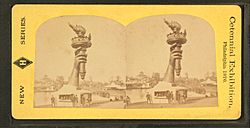
The right arm and torch of the Statue of Liberty were shown at the Exposition. For 50 cents, visitors could climb a ladder to a balcony. The money raised helped pay for the statue's pedestal.
The Pennsylvania Railroad displayed the John Bull steam locomotive, which was built in 1831. The Waltham Watch Company showed the first automatic screw-making machines.
Germany showed off its powerful Krupp guns and heavy cannons. France, on the other hand, displayed fine craftsmanship. Mexico also participated, showing works by prominent painters like José María Velasco.
The Swedish Cottage, a traditional Swedish schoolhouse, was also exhibited. After the fair, it was moved to Central Park in New York. It is now the Swedish Cottage Marionette Theatre.
New Jersey's state pavilion was a copy of the Ford Mansion. This was where George Washington had his headquarters during the winter of 1779–80. It showed "old-fashioned domesticity" with costumed presenters. This exhibit helped start a "Colonial Revival" trend in American architecture.
The Beaver Falls Cutlery Company showed the "largest knife and fork in the world."
See also
 In Spanish: Exposición Universal de Filadelfia (1876) para niños
In Spanish: Exposición Universal de Filadelfia (1876) para niños
- Arts and Industries Building, the Smithsonian in Washington, D.C., built in 1879–1881 to house exhibits from the Centennial Exposition
- Centennial Arboretum
- Centennial comfort stations
- Sesquicentennial Exposition, the 150th anniversary of the United States (1926)
- United States Bicentennial, the 200th anniversary (1976)
- United States Semiquincentennial, the 250th anniversary (2026)
- List of world expositions
- List of world's fairs


